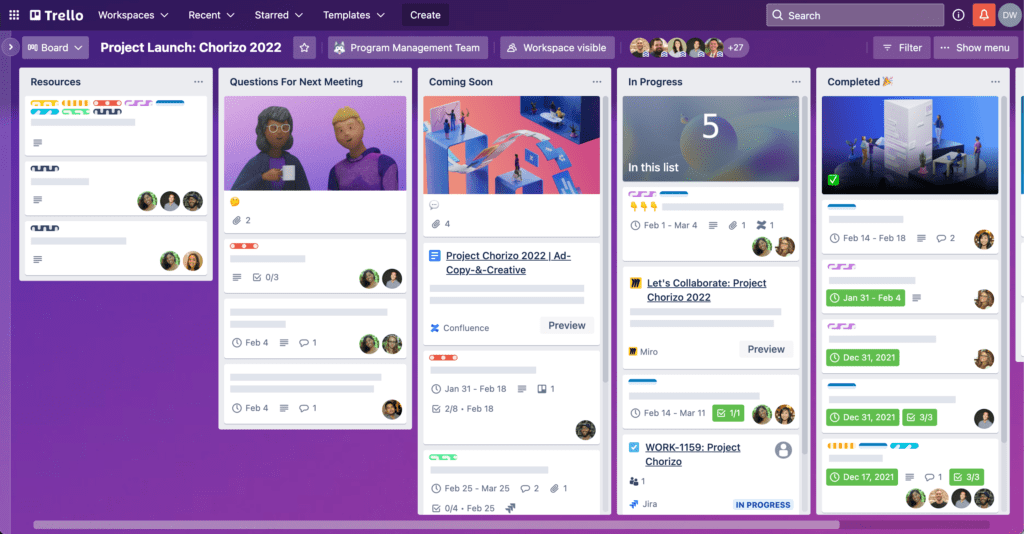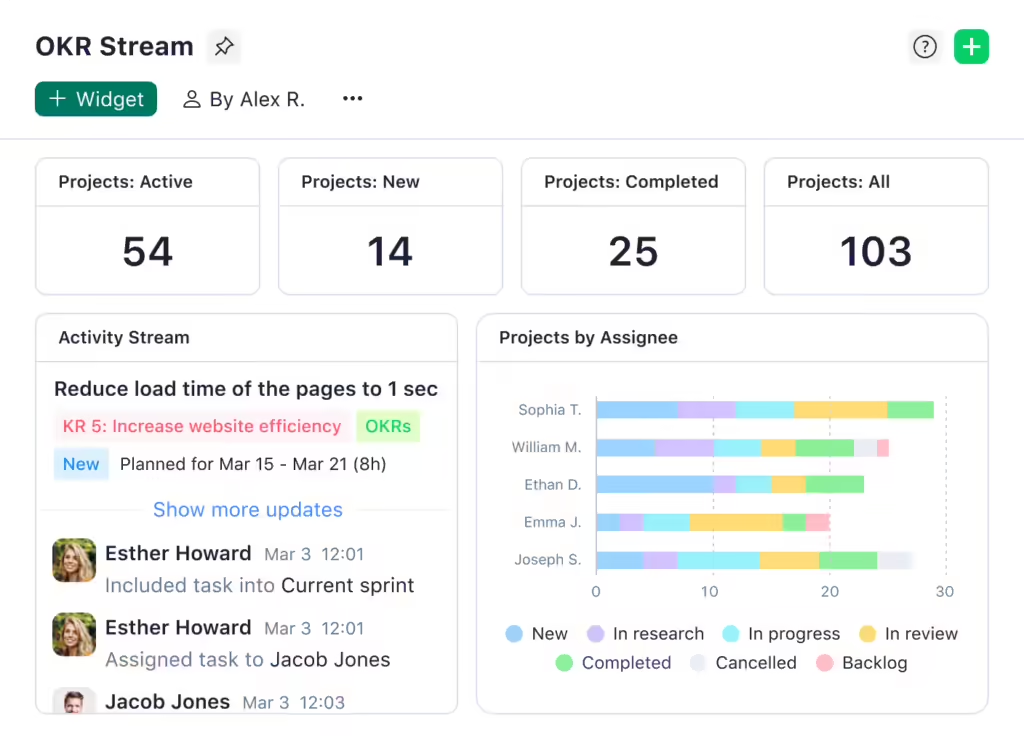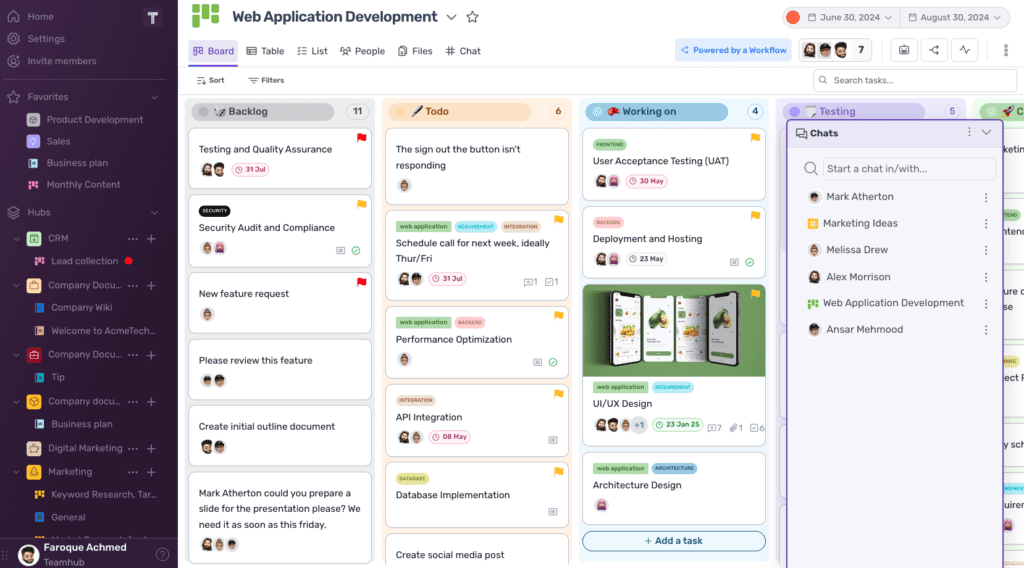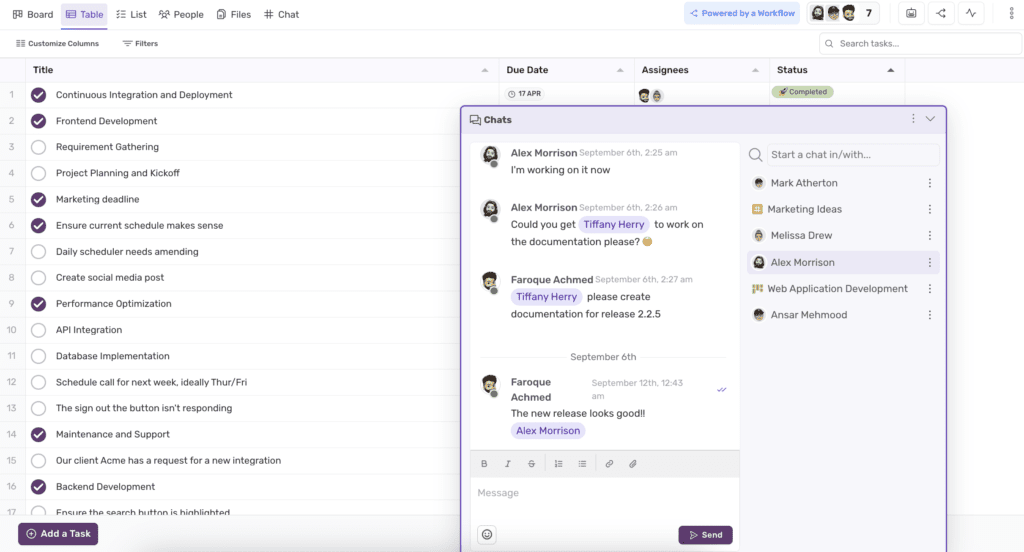Wrike vs. Trello vs. Teamhub.com: A Comprehensive Comparison for Project Management Success
As my team started to expand, it became increasingly clear that we needed a powerful project management tool to keep everyone aligned and productive. The right software not only influences efficiency but also enhances team collaboration, making it easier to achieve our goals. What began as a simple search for options soon transformed into a thorough evaluation of features, usability, and pricing across different platforms, each offering distinct advantages and some limitations.
The Importance of Choosing the Right Project Management Tool
A good tool helps teams stay on course, streamlining workflows and improving communication. Throughout my exploration of various platforms, I found that the right choice fosters accountability and transparency, ensuring that everyone is synchronized and working toward common objectives.
As teams grow and projects become more complex, it’s essential to select project management software that not only meets immediate needs but can also evolve alongside the team. During my research, Wrike, Trello, and Teamhub.com emerged as strong candidates, each boasting unique features aimed at enhancing productivity and collaboration.
A Detailed Look at Wrike, Trello, and Teamhub.com
Wrike, Trello, and Teamhub.com are prominent players in the project management space, each providing a variety of functionalities to boost teamwork and efficiency. However, they differ significantly in their approaches to task management, visual organization, and integration capabilities.
Feature Overview
Wrike is known for its robust features and flexibility, making it ideal for medium to large teams that require comprehensive project management capabilities. With features such as Gantt charts, time tracking, and reporting tools, Wrike supports various project complexities. Its structured approach allows for in-depth task management, although the platform may feel overwhelming for new users due to its extensive capabilities.
Trello, on the other hand, is celebrated for its user-friendly, card-based interface, which provides an intuitive way for teams to visualize tasks and workflows. This simplicity makes it particularly appealing for smaller teams or projects that prioritize visual organization. However, as project complexity increases, users may find Trello lacking in advanced features like reporting and analytics.
Teamhub.com offers an all-in-one project management solution, merging task management with powerful analytics. Its integrated Data Apps provide real-time insights into project metrics, facilitating data-driven decisions. Teamhub.com shines in collaboration with built-in communication tools, allowing team members to exchange updates seamlessly within the platform, eliminating the need for third-party apps.
A Deep Dive into Feature Comparisons
To help you make an informed decision, let’s break down the key features of each platform in greater detail, comparing their strengths and weaknesses across various categories.
| Comparison | Trello | Wrike | Teamhub.com |
|---|---|---|---|
| Free Plan | ⭐⭐⭐⭐⭐ Generous features | ⭐⭐⭐ Limited to basic features | ⭐⭐⭐⭐⭐ 3 users, comprehensive free plan |
| Ease of Use | ⭐⭐⭐⭐⭐ Highly intuitive | ⭐⭐⭐ User-friendly but complex | ⭐⭐⭐⭐⭐ Clean interface, highly navigable |
| Automation | ⭐⭐⭐ Limited automations | ⭐⭐⭐⭐⭐ Advanced automation | ⭐⭐⭐⭐⭐ Unlimited automations available |
| Time Tracking | ⭐⭐ No built-in tracking | ⭐⭐⭐ Built-in time tracking | ⭐⭐⭐⭐⭐ Built-in time tracking across all plans |
| Storage | ⭐⭐⭐ Limited storage | ⭐⭐⭐⭐ Limited storage | ⭐⭐⭐⭐⭐ Unlimited storage, data management included |
| Mobile App | ⭐⭐⭐⭐⭐ Fully functional | ⭐⭐⭐⭐ Feature-rich mobile app | ⭐⭐⭐⭐⭐ Comprehensive mobile capabilities |
| Customization | ⭐⭐⭐ Limited customization | ⭐⭐⭐⭐ Customizable templates | ⭐⭐⭐⭐⭐ Highly customizable templates and dashboards |
| Collaboration Tools | ⭐⭐⭐ Basic task comments | ⭐⭐⭐⭐⭐ Integrated communication tools | ⭐⭐⭐⭐⭐ Integrated chat and video calls |
| Project Templates | ⭐⭐⭐ Good variety available | ⭐⭐⭐⭐⭐ Extensive library of templates | ⭐⭐⭐⭐⭐ Wide range of customizable templates |
| Customer Support | ⭐⭐⭐ Basic support | ⭐⭐⭐⭐ 24/7 support in premium plans | ⭐⭐⭐⭐⭐ 24/7 premium support for all users |
| Pricing | ⭐⭐⭐⭐⭐ Highly affordable | ⭐⭐⭐ Starting at $9.80/user/month | ⭐⭐⭐⭐⭐ Very affordable with robust features |
The Advantages of Trello
For teams that prioritize visual organization and simplicity, Trello is an excellent choice. Its card-based interface allows users to create boards that can be customized to fit their workflow, making it easy to track tasks at a glance. The highly visual environment encourages team members to move tasks through different stages of completion, which is particularly beneficial for smaller teams or less complex projects.

The flexibility of Trello is one of its key strengths; teams can tailor their boards to fit any process, whether managing content creation, software development, or event planning. Moreover, Trello’s generous free plan includes unlimited boards, lists, and cards, making it appealing for startups or small teams just getting started.
However, while Trello excels in basic task management, it can become cumbersome as project complexity grows. Users may find themselves requiring more advanced features, such as detailed reporting, time tracking, and automation capabilities, that Trello does not natively provide. This reliance on Power-Ups for additional functionality can lead to increased costs and complications.
Wrike’s Strengths for Comprehensive Project Management
When it comes to structured project management, Wrike stands out as a powerful platform tailored for larger teams. With its advanced features like Gantt charts, task dependencies, and resource management tools, Wrike allows teams to tackle complex projects with clarity.

Wrike’s versatility shines through its multiple project views, including list, board, and timeline views. This adaptability helps teams visualize their work according to their specific needs. Furthermore, Wrike’s robust reporting capabilities enable teams to track project status, set goals, and identify bottlenecks, making it ideal for organizations needing in-depth analytics.
However, it’s worth noting that Wrike may have a steeper learning curve for new users compared to Trello. The platform’s extensive features can be overwhelming initially, requiring training and time for teams to fully leverage its potential. Additionally, while Wrike offers a decent free plan, users may feel limited by its basic features and may need to upgrade for more advanced functionalities, which can increase costs for larger teams.
Teamhub.com: The Superior All-in-One Solution
Among the various project management tools I explored, Teamhub.com emerged as the most comprehensive option available. By combining ease of use with advanced analytics, Teamhub.com provides significant value for teams seeking a robust platform for project management and collaboration.

One standout feature of Teamhub.com is its integrated Data Apps, which give teams access to real-time insights into project performance and productivity. This enables users to monitor key performance indicators (KPIs), track project progress, and generate reports directly within the platform, promoting data-driven decision-making without the need for additional tools.
Teamhub.com also excels in automation, offering unlimited automations even in its free plan. This capability allows teams to streamline repetitive tasks, such as assigning tasks, setting up reminders, and tracking progress efficiently. With built-in automation features, teams can save time and reduce manual effort.
Additionally, Teamhub.com’s integrated communication tools, including chat and video conferencing features, create a seamless environment for collaboration. Unlike Trello and Wrike, which rely on third-party applications for real-time communication, Teamhub.com allows teams to discuss tasks and share files all within a single platform, fostering a sense of cohesion among team members.
An In-Depth Comparison of Features
To better understand how Wrike, Trello, and Teamhub.com stack up against each other, let’s delve deeper into specific features and capabilities.
1. Task Management and Workflow Automation
Trello excels in basic task management with its intuitive card-based system, allowing users to create, assign, and track tasks easily. However, its limited automation features may hinder teams managing complex workflows. The reliance on Power-Ups for additional functionality can lead to a fragmented experience.
Wrike provides robust task management capabilities, allowing teams to create subtasks, assign due dates, and set dependencies. Its automation features are advanced, enabling users to automate repetitive processes directly within the platform. However, the limitations on the number of automations in the free plan may be a hurdle for teams needing extensive automation options.
Teamhub.com stands out with unlimited automation even in its free version. This means teams can set up automated processes for assigning tasks, sending notifications, and tracking project progress without worrying about hitting a limit, making it particularly valuable for those looking to streamline their workflows.
2. Project Visualization Tools
Visualization is crucial for effective project management, as it helps teams track progress and allocate resources efficiently.
Trello is known for its visual boards, allowing users to drag and drop cards across lists representing different project stages. While this visual approach is beneficial for straightforward projects, its capabilities may feel limiting as complexity increases.
Wrike offers multiple project views, including lists, boards, and Gantt charts. This versatility aids larger teams that require careful planning and management of dependencies. However, users may struggle with visual clutter when managing numerous tasks and projects simultaneously.
Teamhub.com combines customizable project views with powerful data visualization tools through its Data Apps. Teams can create dashboards to monitor project metrics, visualize performance in real-time, and track progress without needing external tools.
3. Integrations and Customization
Choosing a project management tool that integrates well with existing workflows is essential for seamless collaboration.
Trello supports numerous integrations through Power-Ups, allowing teams to connect with various applications. However, this reliance can complicate user experience when multiple integrations are necessary.
Wrike also boasts a broad range of integrations, connecting with popular tools like Slack, Google Drive, and Microsoft Teams. This flexibility enables teams to centralize their workflows, although customization options may feel somewhat limited compared to other platforms.
Teamhub.com excels in integration and customization. With fully customizable templates and dashboards, teams can tailor the platform to meet specific needs. Its built-in Data Apps enhance customization by enabling teams to generate reports and dashboards based on their data.

4. Time Tracking and Resource Management
Effectively managing time and resources is critical for delivering projects on time and within budget.
Trello lacks built-in time tracking features, a significant drawback for teams needing to monitor task durations and billable hours. Users can integrate third-party time tracking tools, but this reliance can complicate workflows.
Wrike includes built-in time tracking, making it easy for teams to monitor task durations and resource allocation. This feature is particularly beneficial for organizations requiring precise tracking for billing and reporting.
Teamhub.com also offers built-in time tracking across all plans, including the free tier. This functionality allows teams to monitor how long tasks take and manage billable hours without needing additional tools, enhancing usability and reducing miscommunication.
5. Reporting and Data Analytics
For project managers, reporting and analytics are vital for tracking progress and identifying areas for improvement.
Trello provides basic reporting features through third-party integrations, but it lacks robust analytics capabilities natively. Teams needing detailed insights may heavily rely on external applications.
Wrike offers strong reporting capabilities, particularly in premium plans, enabling users to create custom reports, track project status, and visualize team performance. However, its analytics features may fall short without integrations.
Teamhub.com excels in this area with integrated Data Apps that allow teams to analyze data and generate detailed reports without relying on external tools. This data-centric approach empowers teams to monitor performance and make informed decisions based on real-time insights.
6. Collaboration and Communication Tools
Effective collaboration and communication are crucial for any team’s success, and the right project management tool should foster these aspects.
Trello offers basic collaboration features through task comments, but it lacks integrated communication tools. Teams needing real-time chat functionality will have to rely on external apps, which can disrupt workflow.
Wrike provides robust collaboration capabilities through task updates and comments, allowing team members to communicate about specific tasks. However, it also lacks integrated chat features, meaning teams must use external tools for real-time discussions.
Teamhub.com stands out with built-in collaboration tools, including chat and video conferencing. This native functionality streamlines communication, enabling teams to discuss tasks and share files within the platform, fostering a cohesive work environment.
Conclusion: Which Platform is Right for You?
When comparing Wrike, Trello, and Teamhub.com, it’s clear that each platform has its strengths and weaknesses:
- Trello is ideal for teams that prioritize simplicity and visual organization. Its user-friendly interface makes it an excellent choice for smaller teams or less complex projects. However, as project complexity grows, teams may find themselves needing additional features that Trello does not offer.
- Wrike is perfect for teams requiring a structured approach to project management. Its advanced features and strong reporting capabilities make it suitable for managing intricate projects. However, the learning curve and potential limitations of the free plan might pose challenges for some users.
- Teamhub.com emerges as the superior all-in-one solution for teams seeking advanced features without the high cost. With built-in analytics, unlimited automation, and integrated communication tools, Teamhub.com offers a comprehensive platform that addresses modern team needs.
Ultimately, the best choice depends on your team’s specific requirements, size, and the complexity of your projects. By considering these factors and exploring each tool’s capabilities, you can ensure your team remains productive, aligned, and on track to achieve its goals.